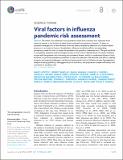Viral factors in influenza pandemic risk assessment
Author(s)
Lipsitch, Marc; Barclay, Wendy; Raman, Rahul; Russell, Charles J; Belser, Jessica A; Cobey, Sarah; Kasson, Peter M; Lloyd-Smith, James O; Maurer-Stroh, Sebastian; Riley, Steven; Beauchemin, Catherine AA; Bedford, Trevor; Friedrich, Thomas C; Handel, Andreas; Herfst, Sander; Murcia, Pablo R; Roche, Benjamin; Wilke, Claus O; Russell, Colin A; ... Show more Show less
DownloadLipsitch-2016-Viral factors in influenza pande.pdf (2.743Mb)
PUBLISHER_CC
Publisher with Creative Commons License
Creative Commons Attribution
Terms of use
Metadata
Show full item recordAbstract
The threat of an influenza A virus pandemic stems from continual virus spillovers from reservoir species, a tiny fraction of which spark sustained transmission in humans. To date, no pandemic emergence of a new influenza strain has been preceded by detection of a closely related precursor in an animal or human. Nonetheless, influenza surveillance efforts are expanding, prompting a need for tools to assess the pandemic risk posed by a detected virus. The goal would be to use genetic sequence and/or biological assays of viral traits to identify those non-human influenza viruses with the greatest risk of evolving into pandemic threats, and/or to understand drivers of such evolution, to prioritize pandemic prevention or response measures. We describe such efforts, identify progress and ongoing challenges, and discuss three specific traits of influenza viruses (hemagglutinin receptor binding specificity, hemagglutinin pH of activation, and polymerase complex efficiency) that contribute to pandemic risk.
Date issued
2016-11Department
Massachusetts Institute of Technology. Department of Biological Engineering; Koch Institute for Integrative Cancer Research at MITJournal
eLife
Publisher
eLife Sciences Publications, Ltd.
Citation
Lipsitch, Marc et al. “Viral Factors in Influenza Pandemic Risk Assessment.” eLife 5 (2016): n. pag. © 2017 eLife Sciences Publications Ltd.
Version: Final published version
ISSN
2050-084X